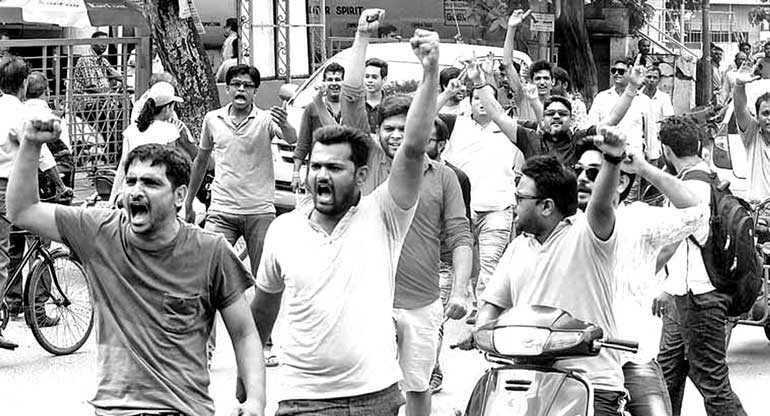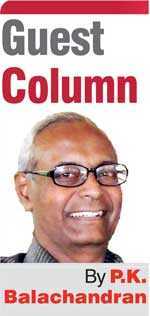Sunday Dec 14, 2025
Sunday Dec 14, 2025
Saturday, 12 January 2019 00:02 - - {{hitsCtrl.values.hits}}

Patidars of Gujarat demand quotas in Government employment
Earlier this week, the Narendra Modi Government got the Indian Parliament to pass the 124th Constitutional Amendment bill to give 10% reservation for the “poor” among the “Forward Castes” or communities in the country.
This was to address a long-standing complaint from these communities that, in the existing reservation system for jobs in Government institutions and places in Government educational institutions, the Forward Castes have no quota, while the Scheduled Castes (ST), Scheduled Tribes (ST) and Other Backward Classes (OBC) each have a fixed quota.
The Forward Castes and communities are classified as the “General Category” and Government jobs and places in educational institutions are given to them on the basis of competition open to all communities.
The Indian constitutional reservation system with quotas for SCs, STs and OBCs was instituted to address the primordial social and educational inequalities which were based on the institution of caste, a hierarchical Hindu social and economic order based on birth. In most States (provinces) the communities identified as “forward” were the Brahmin, Kshatriya and Vaishya castes and also certain peasant castes which are numerically, economically ,politically and socially dominant. Among the latter are castes such as the Jats, Marathas, Patidars and Vellalas.
For over 3,000 years, the non-forward castes, now classified as OBCs, SCs and STs, were oppressed and denied opportunities for education and progress, while the Forward Castes forged ahead.
However, as a result of some socio-political movements, independent India drew up a constitution which gave the SCs (previously dubbed untouchable) 15% reservation, and the STs 7.5%. Then, in 1989-1990, the Government set apart 27% for the OBCs. Some States like Tamil Nadu had already done so and 68% of the places were in the reserved category.
To restrain governments from expanding the reserved category to meet political ends through vote bank politics, the Supreme Court ruled that reservation should not exceed 50% of the total places up for grabs.
The reservation system has come under fire periodically. Many castes have clamoured to be included in the reserved category. The most Forward Castes have been totally against reservation as it militates against the operation of merit. Others have said that an economic criterion should be introduced to take out the rich from the list so that the facilities go to the really needy.
The Central and State Governments have tried to introduce an economic criterion so that the poor among the Forward Castes benefit. But the Judiciary would always disallow these moves because the constitution does not recognise reservation based on economic criteria. Quite rightly, the constitution only recognises primordial (and still existing) “social disability” as the basis of deep-rooted prejudice and of denial opportunities.
Some States included Forward Castes in the Backward Class category. But this was frowned upon by the courts. Some States introduced reservation on the basis of poverty but the constitutionality of these could be questioned.
Arguments against economic criterion
Arguments against reservation based on economic criteria are many: One of them is that wealth is not automatically translated into social status in traditional societies as in India. Markers of high status here are accessibility to certain institutions and spaces like the temple, the dining area, types of work, government jobs of a particular kind, and access to education of a particular kind. Possession of wealth is no guarantee that the possessor has access to such places of status. It is often said that a poor Brahmin youth has greater access to the socially valued places than a wealthy person from a depressed caste.
However, as democracy spreads, education and jobs which confer high status begin to be sought by Backward Castes/SCs/STs as well as the Forward Castes. The wars over reservation are over a share of this cake.
The second argument against economic criteria is that wealth is not static, unlike caste. One can acquire wealth and lose wealth. One can be poor today and wealthy tomorrow. But caste is static. One is born into a caste and is stuck with it lifelong. In a caste society such an affiliation can be quite debilitating.
The third objection to economic criteria is that it is difficult to determine and quantify poverty because notions of poverty vary from time to time depending on changing economic circumstances and value systems. And yardsticks to measure poverty have kept changing.
According to the World Bank, 270,000 000 Indians or one-fifth of Indians are poor. 75% of rural households in India have a monthly income of less than Rs. 5,000 ($ 79). Rs. 5,000 per month per household with an average household size of five would also mean an income of Rs. 33 per person per day in the rural areas.
More than 70 million rural households face some form of exclusion, either from assets or socio-economic benefits, according to data released by the Socio-Economic Caste Census (SECC). India Spend recently reported how rural India has more illiterate people than the population of Indonesia.
Because the idea of poverty varies even from State to State, for the purpose of reservation, the Government has left it to the State governments to decide on the markers of poverty.
Challenges in implementation
Be that as it may, the question that still remains is how governments are going to fill the 10% quota for the poor. The majority of Indians of most castes are poor. And being poor they cannot get the right kind of education and training to fill the middle and higher level jobs in the Government.
And governments in India are still small, with a total workforce of only 15 million. Therefore, governments can accommodate only a small fraction of the 13 million youths who join the work force every year. And reservation applies only to Government institutions.
Overall in India, job creation has averaged only 500,000 per year according to Labour Bureau statistics. Trade unions also complain that governments have been increasingly resorting to contractual employment abandoning permanent employment.
And governments have not even been filling posts which ought to go to the reserved categories. According to data secured through the Right to Information Act, only 9,040 out of the 79,483 employees in select ministries and departments of the Central government were from the OBC.
This being the case, how will 10% reservation for the poor of the Forward Classes help? What purpose will it serve other than giving Prime Minister Modi a propaganda devise to help him recover from the shock defeats his Bharatiya Janata Party (BJP) received in the crucial pre-parliamentary elections in Rajasthan, Madhya Pradesh and Chhattisgarh?
Constitutionality in question
Furthermore, the reservation act is yet to pass the test of constitutionality in the Supreme Court. As soon as the Act was passed, Youth for Equality, an NGO, sought the quashing of the bill, saying that economic criterion cannot be the sole basis for reservation. Also, reservation on economic grounds cannot be limited to the General Category (Forward Castes). And the 50% ceiling limit set by the Supreme Court cannot be breached.